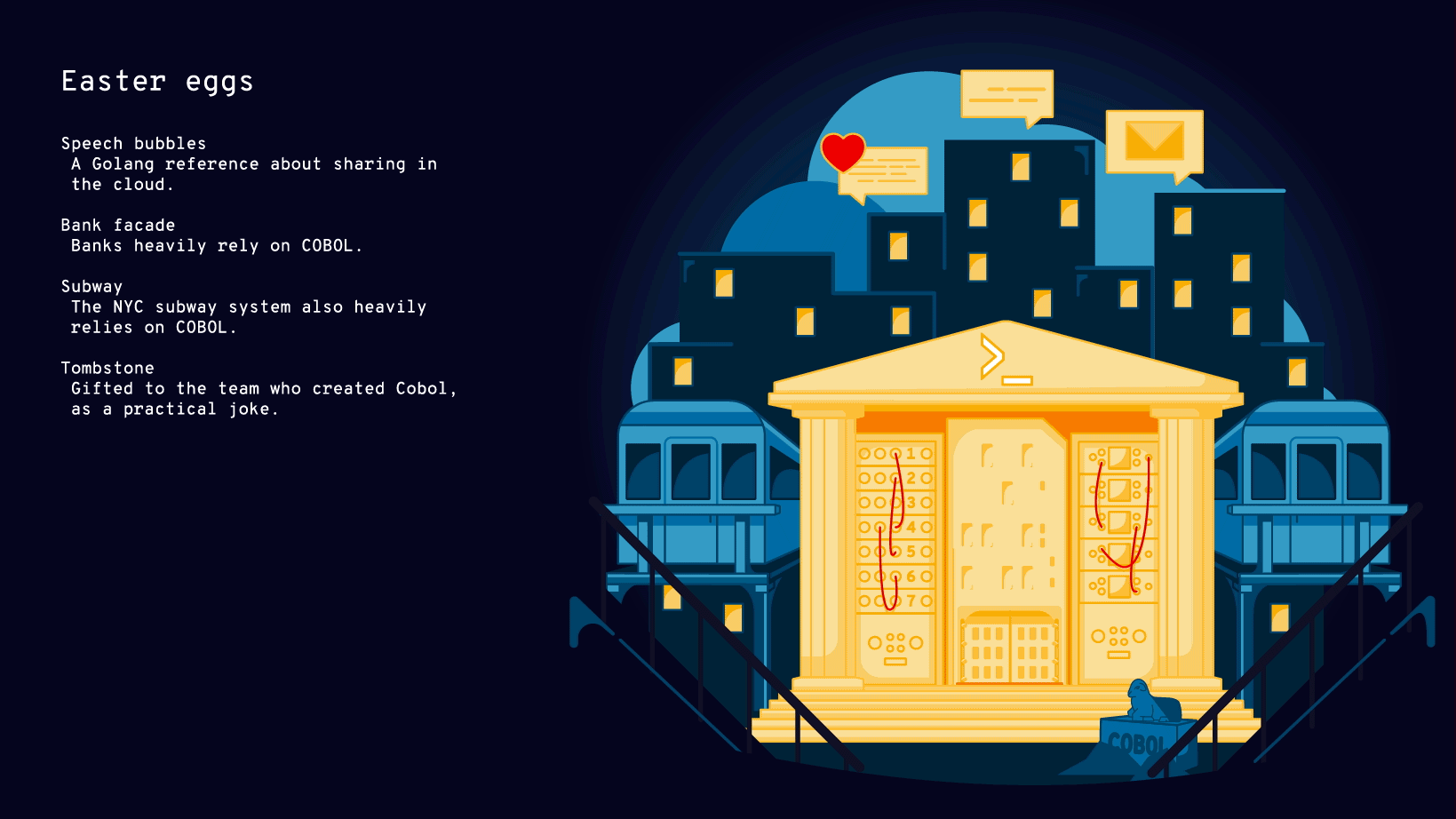Most of our episodes feature languages that have clear arcs. "The Infrastructure Effect" was different. By all accounts, COBOL is a language heading the way of Latin. There are only a few specialists who are proficient COBOL coders. But it’s still vital to many long-lasting institutions that affect millions: the banking industry, the IRS, and manufacturing. And the world of tech infrastructure is moving on—to Go. Where does that leave COBOL in the next few years? And how do you tease all of that in an image?
We had to decide what visual themes could we use to depict each language—and then, how to combine them into a single, coherent frame. COBOL and Go have a similar function, so we wanted to make sure each language had clear, distinct imagery. We decided to rely on some of their real-world applications: the bank and subways for COBOL, and the cloud-based applications for Go.
What was your research process for uncovering the histories of COBOL and Go?
Karen Crowson, Designer: COBOL has been around a lot longer than Go. It was easy to find information on COBOL thanks to the people involved: they were big names in the 60’s tech world. Go, on the other hand, is relatively new. There wasn’t a lot to go on there, other than we know what it does, who created it, and how it affects our lives.
Johan Philippine, Copywriter: Those limitations for Go became our starting point—function, rather than logos or origins. We also liked that the imagery would reinforce how important these languages are to our lives—despite most people not being aware of them.

What’s the coolest/most surprising thing you learned about COBOL and GO?
Karen: The best part was seeing the sense of humor the people who created COBOL had. When I think of it, I think of this old language that runs things like the bank, government, etc. Very rigid. But during its development, one of the people on the team that was developing the language sent a colleague a tombstone with the word “COBOL” on it. Poking fun at the fact that this could go nowhere. It did though.
Johan: I love that irony too. It’s funny, but it’s also a reminder that you can’t know for sure what will become important and whether a project will survive disagreement. The team member was angry enough to wait for weeks for his package and then send it out. But in spite of early issues, COBOL outlived everyone’s expectations. Who knows, it might even outlive that tombstone. It’s a great story with an easy to include visual.
What was your biggest influence for this episode’s art?
Karen: COBOL in general. It runs things that affect us everyday. I thought that was important to show. It also has a rich history that it wasn't hard to be inspired by.
Johan: It had to be COBOL. So much of the episode revolves around the idea that infrastructure can’t be easily replaced—even when something more modern is available. COBOL and Go are concurrent. We wanted to emphasize just how resilient COBOL is to the past 50-odd years of change.
What was the most difficult part to draw?
Karen: The subways. I had to frame the bank, but make sure the subways didn’t compete for attention. To make it work, I had to put in this forced perspective while trying to keep our flat style too. Giving the sense that this is an active city was difficult too, as was figuring out just how to include the looming clouds.
We always aim for the art to leave a lasting impression—and it was a particular focus for this episode. The Infrastructure Effect’s artwork is available for download on the episode page. Next time, we’ll share how we came up with the visuals for Heroes in a Bash Shell.
Sull'autore
Ricerca per canale
Automazione
Le ultime novità sulla piattaforma di automazione che riguardano la tecnologia, i team e gli ambienti
Intelligenza artificiale
Aggiornamenti sulle piattaforme che consentono alle aziende di eseguire carichi di lavoro IA ovunque
Servizi cloud
Maggiori informazioni sul nostro portafoglio di servizi cloud gestiti
Sicurezza
Le ultime novità sulle nostre soluzioni per ridurre i rischi nelle tecnologie e negli ambienti
Edge computing
Aggiornamenti sulle piattaforme che semplificano l'operatività edge
Infrastruttura
Le ultime novità sulla piattaforma Linux aziendale leader a livello mondiale
Applicazioni
Approfondimenti sulle nostre soluzioni alle sfide applicative più difficili
Serie originali
Raccontiamo le interessanti storie di leader e creatori di tecnologie pensate per le aziende
Prodotti
- Red Hat Enterprise Linux
- Red Hat OpenShift
- Red Hat Ansible Automation Platform
- Servizi cloud
- Scopri tutti i prodotti
Strumenti
- Formazione e certificazioni
- Il mio account
- Risorse per sviluppatori
- Supporto clienti
- Calcola il valore delle soluzioni Red Hat
- Red Hat Ecosystem Catalog
- Trova un partner
Prova, acquista, vendi
Comunica
- Contatta l'ufficio vendite
- Contatta l'assistenza clienti
- Contatta un esperto della formazione
- Social media
Informazioni su Red Hat
Red Hat è leader mondiale nella fornitura di soluzioni open source per le aziende, tra cui Linux, Kubernetes, container e soluzioni cloud. Le nostre soluzioni open source, rese sicure per un uso aziendale, consentono di operare su più piattaforme e ambienti, dal datacenter centrale all'edge della rete.
Seleziona la tua lingua
Red Hat legal and privacy links
- Informazioni su Red Hat
- Opportunità di lavoro
- Eventi
- Sedi
- Contattaci
- Blog di Red Hat
- Diversità, equità e inclusione
- Cool Stuff Store
- Red Hat Summit

